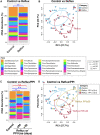Gastroesophageal reflux and PPI exposure alter gut microbiota in very young infants
- PMID: 38027267
- PMCID: PMC10651085
- DOI: 10.3389/fped.2023.1254329
Gastroesophageal reflux and PPI exposure alter gut microbiota in very young infants
Abstract
Importance: Infants with symptomatic Gastroesophageal reflux are treated with pharmacological therapy that includes proton pump inhibitors (PPI) with clinical improvement. The alterations to gut microbiome profiles in comparison to infants without reflux is not known.
Objective: To determine the effect of PPI therapy on gut bacterial richness, diversity, and proportions of specific taxa in infants when compared to infants not exposed to acid suppressive therapy.
Design setting and participants: This cohort study was conducted at the Stony Brook Hospital in Stony Brook, NY between February 2016, and June 2019. Infants meeting inclusion criteria were enrolled in a consecutive fashion.
Results: A total of 76 Infants were recruited and 60 were enrolled in the study, Twenty nine infants met clinical criteria for reflux and were treated with PPI therapy: median [IQR] gestation: 38.0 weeks [34.7-39.6 weeks]; median [IQR] birthweight: 2.95 Kg [2.2-3.4]; 14 [46.7%] male) and 29 infant were healthy controls median [IQR] gestation: 39.1 weeks [38-40 weeks]; median [IQR] birthweight: 3.3 Kg [2.2-3.4]; 17 [58.6%] male); 58 stool samples from 58 infants were analyzed. There were differences in Shannon diversity between the reflux and control groups. The reflux group that was exposed to PPI therapy had increased relative abundance of a diverse set of genera belonging to the phylum Firmicutes. On the other hand, the control group microbiota was dominated by Bifidobacterium, and a comparatively lower level of enrichment and abundance of microbial taxa was observed in this group of infants.
Conclusions and relevance: We observed significant differences in both α- and β-diversity of the microbiome, when the two groups of infants were compared. The microbiome in the reflux group had more bacterial taxa and the duration of PPIs exposure was clearly associated with the diversity and abundance of gut microbes. These findings suggest that PPI exposure among infants results in early enrichment of the intestinal microbiome.
Keywords: dysbiosis; gastroesophageal reflux; infants; microbiome; proton pump inhibitors.
© 2023 Gathungu, Francis, Chawla, LaComb, Robertson, Askinazi and Frank.
Conflict of interest statement
The authors declare that the research was conducted in the absence of any commercial or financial relationships that could be construed as a potential conflict of interest.
Figures



References
-
- Vandenplas Y., Rudolph C.D., Di Lorenzo C., Hassall E., Liptak G., Mazur L., Sondheimer J., Staiano A., Thomson M., Veereman-Wauters G., Wenzl T.G.H, North American Society for Pediatric Gastroenterology, Nutrition, and H. European Society for Pediatric Gastroenterology. Pediatric gastroesophageal reflux clinical practice guidelines: joint recommendations of the north American society for pediatric gastroenterology, hepatology, and nutrition (NASPGHAN) and the European society for pediatric gastroenterology, hepatology, and nutrition (ESPGHAN). J Pediatr Gastroenterol Nutr. 49 (2009) 498–547. 10.1097/MPG.0b013e3181b7f563 - DOI - PubMed
Grants and funding
LinkOut - more resources
Full Text Sources
Miscellaneous

